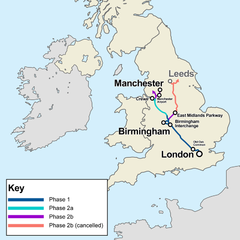HS2
 Most of the phase 2b eastern leg is cancelled | |
High Speed 2 (HS2) is a planned high-speed railway network in the United Kingdom between London and Manchester, with the first phase between London and Birmingham currently under construction.[1] The project is in three phases: whilst phase 1 is already under construction, phase 2a, from Birmingham to Crewe, awaits funding approval, and the specification has not yet been finalised for phase 2b, between Crewe and Manchester and branch line between Birmingham and the East Midlands. The railway will be the country's second purpose-built high-speed line, the first being High Speed 1 (HS1) which connects London to the Channel Tunnel.
The network of track will have a design speed of 400 km/h (250 mph) and some HS2 trains will be capable of operating on the existing conventional network, reaching locations off the HS2 network using mixed HS2/conventional network services. High Speed 2 will provide upgrades to the terminal stations of London Euston and Manchester Piccadilly, whereas Birmingham will be served by a new terminus known as Birmingham Curzon Street.
The project has been subject to both support and opposition. Supporters of the project believe that HS2 will provide increased capacity and reliability to cater for rising passenger numbers while driving further modal shift to rail. Opponents believe that the project is neither environmentally nor financially sustainable.[2]
Review
In 2019 in response to criticism, the government ordered a review of the project chaired by the project's former chairman, Douglas Oakervee, which recommended that the entire project proceed as planned. The costs of HS2 were estimated in 2010 to be between £30.9 billion and £36 billion; in 2015, this estimate was combined with the cost of rolling stock and adjusted for inflation to give a budget of £56.6 billion. Oakervee's review in 2019 estimated the project would cost between £80.7 billion and £106 billion in 2019 prices. Construction on the line began in 2020 and tunnelling for the first phase began under the Chiltern hills on the outskirts of London in 2021.
Change of plan
Originally, HS2 was to consist of a “Y” network, with two legs forking at Birmingham to Manchester and Leeds. However in November 2021, as part of the Integrated Rail Plan for the North and Midlands, it was announced that phase 2b from Birmingham via the East Midlands to Leeds, (known as the eastern leg), would have most of the leg scrapped.
The branch section from Birmingham to Toton near Nottingham will remain, being diverted to nearby East Midlands Parkway where it runs north onto the Midland Main Line. Upgrading existing lines to serve Leeds, Sheffield and Newcastle was favoured instead of building the whole eastern leg.[3]
Cost inflation
| Dennis Skinner on HS2 |
In 2020 the Beast of Bolsover was at his best in a video, speaking at a village hall on the route of HS2:
"£120 Billion pounds to get to London 30 minutes earlier. If you need to get to London 30 minutes earlier, try getting up 30 minutes earlier."
HS2 has been hailed as the “biggest infrastructure decision since World War Two” but the estimated cost of building the high-speed railway could be spent on better projects. Dennis Skinner added:
- “Could I spend that money in a different way? And the answer is yes, every time!”
Transpennine connectivity
From the launch of the HS2 project in 2009/10, its most glaring deficiency – the inability of the proposed HS2 ‘Y-network’ to offer any improved transpennine link between Northern cities – caused immense concern amongst regional political and business leaders.
It was perfectly obvious that a system which only provided high speed links from Northern cities to London, and which failed to interlink Northern cities, could only have the effect of sucking economic activity out of the North, and exacerbating the North-South Divide.
The launch in 2014 of then-Chancellor George Osborne’s Northern Powerhouse initiative was intended to address these connectivity concerns. ‘HS3’ transpennine high speed rail links would interconnect Liverpool, Manchester, Sheffield, Leeds, Hull and Newcastle, and thus complement HS2.
A comprehensive and exacting specification was established by the ‘One North’ group of city councils; this included the key requirements for radically reduced journey times and for a single new east-west transpennine railway, fully integrated with the north-south HS2. And with this transformed connectivity, the promised ‘Northern Powerhouse’ should come about.
This at least was the theory; the reality has turned out to be somewhat different. Under the leadership of Transport for the North (TfN), ‘HS3’ has been descoped to a programme of ‘Northern Powerhouse Rail’ upgrades, with only limited new-build proposed, and every attempt made to utilise sections of HS2 as part of the new intercity routes.
Accordingly, the Liverpool-Manchester link will follow HS2’s Manchester spur running via Manchester Airport, and the Sheffield-Leeds link will follow part of the HS2 route in Yorkshire. Regrettably, no-one in authority appears to have recognised the illogicality of basing HS3/Northern Powerhouse Rail – whose core rationale is the improvement of east-west transpennine connectivity – upon sections of HS2, which were designed to exclusively north-south priorities, with no thought for transpennine connectivity.[4]
References
Wikipedia is not affiliated with Wikispooks. Original page source here